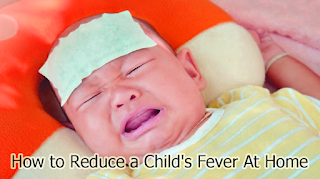How to Reduce a Child's Fever At Home
How to reduce a child's fever at home you can do when your child has a fever. However, when you do treatment at home, you must be more careful about your child's condition and be aware of symptoms that are already showing signs of danger.
Fever that occurs in children is not always dangerous and most will subside on their own within a few days. Actually, fever is the body's reaction to fight infection in the body naturally. These infections can be caused by viruses, bacteria or parasites.
Several other conditions can also cause fever, such as the effects of immunization or autoimmune disease. For fevers that are classified as mild, there are several ways to reduce fever in children naturally that can be done at home.
How to Reduce a Child's Fever Naturally
Children who have a fever are characterized by their body temperature rising to 38 degrees Celsius or more. To find out your child's body temperature, you can check it using a thermometer. In addition, when a child has a fever, they may also look weaker, restless, cry often, have difficulty sleeping, and reduce appetite and drinking.
To reduce fever in children, as first aid you can do the following:
1. Give compress
To reduce fever in children, try giving a compress to him using a cloth or towel that has been moistened with plain or slightly warm water for 20 to 30 minutes.
Compress on the forehead, chest, stomach, or armpit area while your child is sleeping or lying down. Don't forget to re-wet when the compress starts to dry. In addition, you also need to check the child's body temperature regularly every 1-2 hours after you compress it.
2. Don't give thick clothes
Give clothes for your child with clothes made from comfortable and not too thick. This is because when your child wears thick clothes, his body will become hot and it is difficult to remove body heat, so the fever will be difficult to subside.
If your child feels cold or feverish, wear comfortable clothes that can absorb sweat and cover him with a light blanket.
3. Provide enough food and drink for children
Make sure the fluid and nutritional needs for children are fulfilled so that children avoid dehydration. If you are still giving exclusive breast milk to your child, make sure the child is breastfed as often as possible.
However, if your child has started eating solid foods, you can continue giving breast milk while giving enough water. Make sure the water you consume comes from a protected water source, so that the natural mineral content in it is still maintained.
When the child has a fever, the provision of food and fluid intake must remain selective. If the child's age has reached 1 year or more, you can give him an electrolyte isotonic drink which has benefits for those who have a fever.
The reason is that when a child has a fever, the body will excrete more fluids through sweat and urine. Therefore, so that the child does not become dehydrated, these fluids need to be replaced. Well, giving this electrolyte isotonic drink is absorbed more quickly by the body to replace the lost body fluids.
4. Bathe using warm water
You are still allowed to bathe the child when the child has a fever, as long as you use warm water. Do not bathe the child using cold water, because it can cause the child's body temperature to increase and make the child shiver because he feels cold.
5. Maintain room temperature
Make sure the temperature in the room remains cool and comfortable for your child. You can turn on the air conditioner, but make sure it's not too cold. You can also use a fan, but at a lower speed.
Keep in mind do not direct the air conditioner or fan facing your child's body directly because it can make it cold.
6. Give fever reliever medication
If necessary, you can give medicine to reduce fever in children, such as paracetamol. With the provisions, the dose of paracetamol must be adjusted to the age and weight of the child or according to the instructions for use listed on the packaging.
You should not give this medicine to babies who are less than 2 months old without the permission of the doctor.
Fever to Look Out For
If after trying the methods above but the results are not effective in reducing your child's fever, then you should immediately take your child to the doctor for further examination. Moreover, if the fever in children does not subside after two days and is accompanied by the following symptoms:
- The child is dehydrated with signs such as dry lips, vomiting, diarrhea, crying without tears, not wanting to breastfeed, not wanting to eat, rarely or not urinating at all.
- Febrile seizures in children
- Child looks weak
- The child's skin becomes pale or looks bluish
- Children often sleepy
- Child has severe headache
- Child has shortness of breath
- Child has fainted
How to reduce a child's fever at home you can indeed do. However, you also need to closely monitor the progress of the treatment you provide. If it does not improve and shows any symptoms as mentioned above, you should immediately take your child to the doctor for proper treatment.
